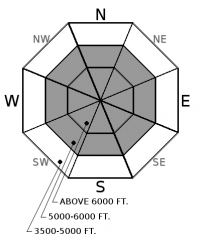| Tuesday | Tuesday Night | Wednesday | |
|---|---|---|---|
| Cloud Cover: | Increasing clouds | Rain showers decreasing | Mild and mostly cloudy |
| Temperatures: | 46 to 51 deg. F. | 28 to 33 deg. F. | 42 to 47 deg. F. |
| Wind Direction: | S | SW | SW |
| Wind Speed: | 5 to 15 mph, gusting to 30 | 5 to 15 mph, gusting to 30 | 2 to 12 mph |
| Snowfall: | 0 in. | 0 in. | 0 in. |
| Snow Line: |
Whitefish Range
Swan Range
Flathead Range and Glacier National Park
How to read the forecast
Warming temperatures, sunshine, and rain showers will increase the threat of shallow loose wet avalanches on Tuesday. Look for rollerballs to indicate decreasing stability. Cooler temperatures on Wednesday should curb wet concerns. An increase in southwest winds through Tuesday night could form small wind slabs on high elevation, leeward terrain. Watch for blowing snow or thicker drifts.

No Rating
?
Above 6500 ft.
No Rating
?
5000-6500 ft.
No Rating
?
3500-5000 ft.
-
Type ?
-
Aspect/Elevation ?

-
Likelihood ?CertainVery LikelyLikelyPossible
 Unlikely
Unlikely -
Size ?HistoricVery LargeLargeSmall

Tuesday's weather will bring warming temperatures, morning sunshine, and a possibility of light rain showers in the afternoon. As the snow surface moistens, the potential for shallow wet sluffs will increase, especially at higher elevations. Pinwheels, rollerballs, or rain on dry snow are signs of decreasing stability suggesting it is time to move towards colder snow or lower slope angles. Small, loose wet avalanches are most dangerous in long-running gullies or above cliff bands. Cooler temperatures on Wednesday should prevent this problem from developing.
-
Type ?
-
Aspect/Elevation ?

-
Likelihood ?CertainVery LikelyLikelyPossible
 Unlikely
Unlikely -
Size ?HistoricVery LargeLargeSmall

Southerly winds are forecasted to increase on Tuesday and Tuesday night, which could cause small, wind-drifted slabs to form below ridgelines and in cross-loaded terrain features at higher elevations. Blowing snow or cracking snow are signs of instability. Identify and avoid lenses of freshly drifted snow above consequential terrain.
Shallow surface instabilities will be the most common avalanche problems over the next two days. Tuesday will be the warmest day of this week, with freezing levels climbing above 6,000'. Surface warming looks like it will be amplified by some morning sunshine, green-housing clouds, and afternoon rain showers. The most reactive snow surfaces for loose wet avalanches on Tuesday will be at upper elevations, where you can still find loose, unconsolidated powder on some slopes. This loose snow has potential to drift into shallow wind slabs if we see winds increase as forecasted. The last round of snowfall was relatively dense and there isn't much snow available for transport; I expect wind slab formation will be isolated to the highest peaks or slopes with larger fetches. On Tuesday afternoon, we could pick up another inch or two of new snow available for drifting at the highest elevations.
Warm temperatures over the last few days have helped all of the storm snow from this month consolidate and gain strength. On a few slopes, we have found faceted snow surrounding the rain or sun crusts that are now buried 1 to 3 feet deep. This persistent slab problem is unlikely to trigger, but it is still worth assessing because of the larger potential size. I was unable to find problematic weak layers in recent tours to the Flathead Range, Central GNP, and Swan Range, but Chris found reactive facets on Sunday in Southern GNP. The natural slab avalanches from the Skook Chutes also looked like they ran on recently buried crusts. I might grab the microphone here to point out a few things we can learn from this incident. There were hundreds of people who traveled under those paths on Sunday, myself included, and some folks narrowly missed getting hit by the slides. I think we all know the Canyon is a serious terrain trap, but it is easy to become complacent in our snowpack assessments and travel techniques because of the social proof (i.e. herding instinct) and familiarity heuristics. If you and your partners have assessed that terrain as an appropriate choice for the day's conditions, apply a few of these simple travel strategies to reduce your risk. It might be the difference between a close call and a tragedy.
-Always carry a beacon, shovel, and probe. The odds of a successful companion rescue are pretty slim without them.
-Space out from your partners as you egress underneath those paths. Your partner can't initiate a rescue response if s/he is also buried. Multiple burials require more time and resources; the odds of surviving are lower.
-Keep your eyes on the terrain above you. On Sunday, someone saw the first natural release and shouted to the hikers on the road to watch out. They were able to move into relative safe zones before the debris hit the road. Of course, a larger avalanche out of that terrain eliminates the chance of escaping because the entire gulley will get filled with debris (see this example).
Tuesday will increasing clouds and winds ahead of a small disturbance. Mountain temperatures will climb into the 40s, and we could see a light rain/snow mix at higher elevations this afternoon. Gusty winds and light showers fad overnight and Wednesday brings a break from precipitation and cooler weather.
This advisory applies only to backcountry areas outside established ski area boundaries. This advisory describes general avalanche conditions and local variations always occur. This advisory expires at midnight on the posted day unless otherwise noted. The information in this advisory is provided by the USDA Forest Service who is solely responsible for its content.



























